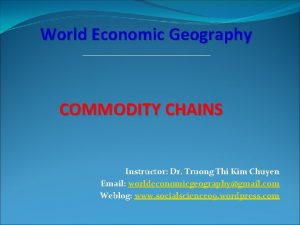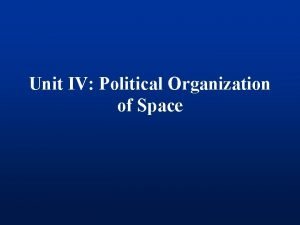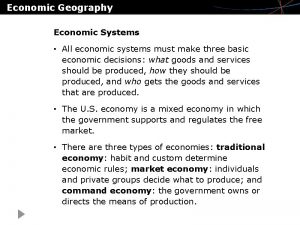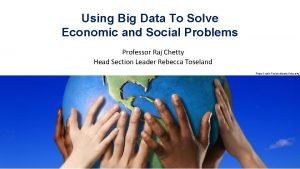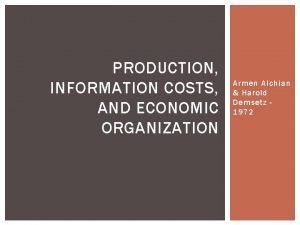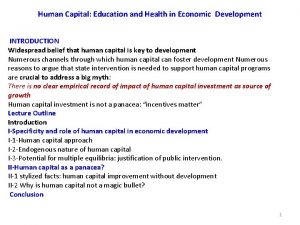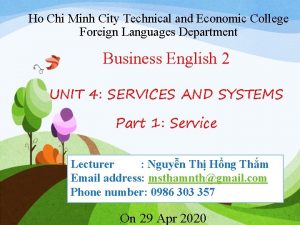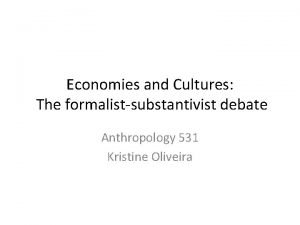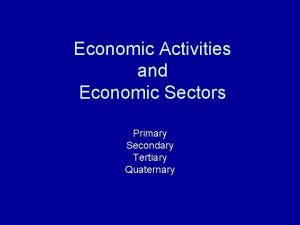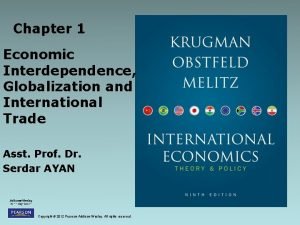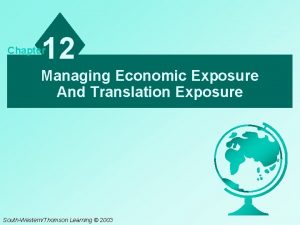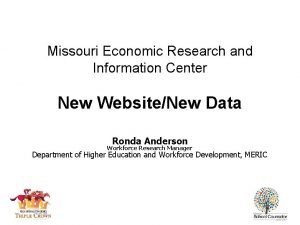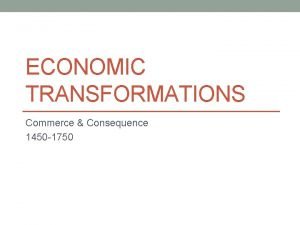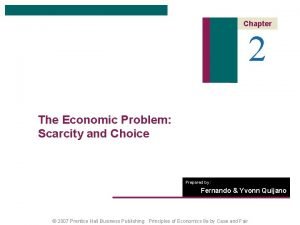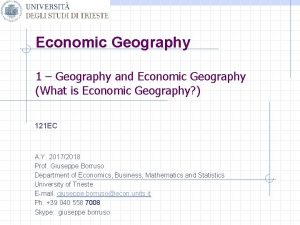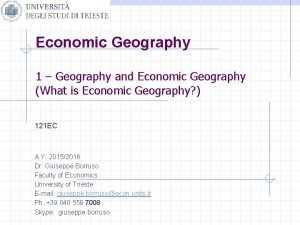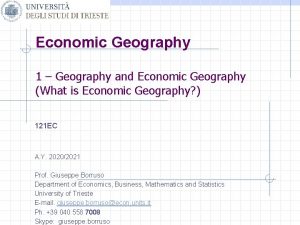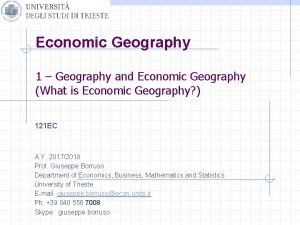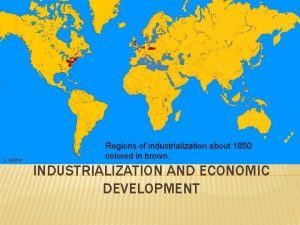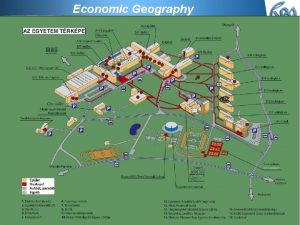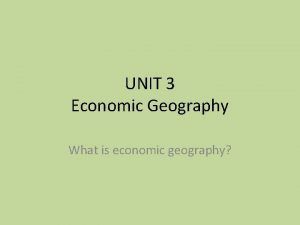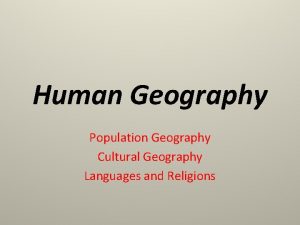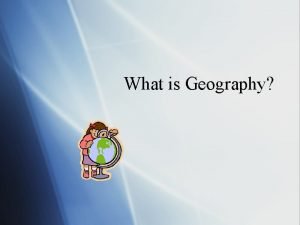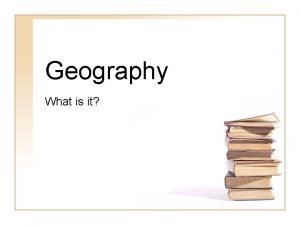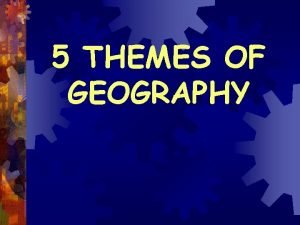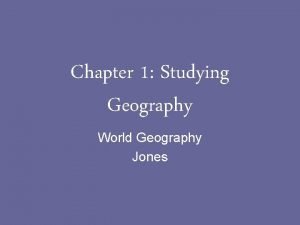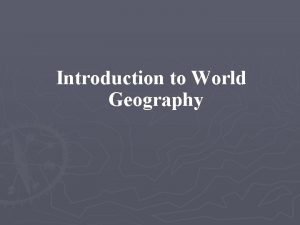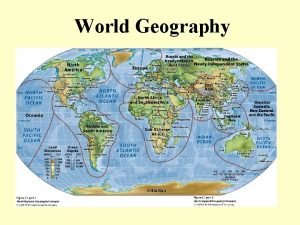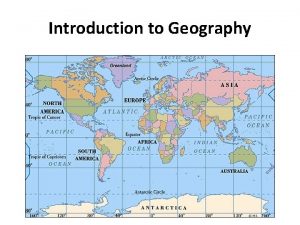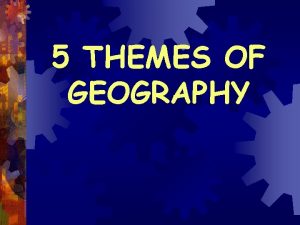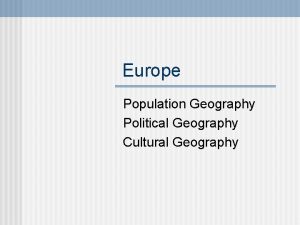Economic Geography 1 Geography and Economic Geography What






























- Slides: 30

Economic Geography 1 – Geography and Economic Geography (What is Economic Geography? ) 121 EC A. Y. 2015/2016 Dr. Giuseppe Borruso Faculty of Economics University of Trieste E-mail. giuseppe. borruso@econ. units. it Ph. +39 040 558 7008 Skype: giuseppe. borruso

Learning Objectives w In general: provide the instruments that can help explaining the locations of economic activities and the relationships between activities located in space w In this lesson we will: n n Start to think why ‘geography matters’; Explore the links between geography and economics; Define a geographical space and the topics of economic geography; Express a definition of economic geography and its study area.

Topics 1. Geographical space, geographical 2. 3. 4. 5. concepts and Economic Geography What is economic Geography? Origins and evolutions of Economic Geography Geographical models and the study of human space Models in Economic Geography (anticipation)

Geographical Space and Economic Geography (1/4) w Geography (today) n n = science of interpretation of the organized space Studies issues connected to w Localisation (= precise spatial position of objects within a particular area of Hearth’s surface) w Human – environment relationship w Regions and identification of the distinctive characters of particular partitions of space n Role of geography. Supply: w Positional information on the exact position of events; w Environmental information on quality of particular areas; w Optimization = finding the ‘best’ position for things and the ‘best’ use of areas w Geographical space n n = part of the Earth’s surface inhabited, lived and organized by human beings. Realm in which human actions take place and interact with nature. w Environment = total sum of the conditions that regard and individual in a given point on the Earth’s surface

Geographical Space and Economic Geography (2/4) w Geography Concepts n n n n Location/Place Location: Where is it? Place: What is it like? Environment The surrounding air, land, and water shared by all living and non-living things Interaction The relationship between people and the environment and the resulting patterns/ consequences Region An area with common characteristics that are different from those of surrounding areas Movement The exchange among places of products, people, and ideas Pattern An arrangement of features Sustainability Ensuring renewal and re-growth of resources as they are consumed (used) Stewardship Human responsibility for the Earth’s well-being

Geographical Space and Economic Geography (3/4) w 1 st law of Geography (Tobler, 1970): “Everything is related to everything else, but near things are more related than those far apart” (distance decay effect) n n => Law: spatial autocorrelation (statistics) – if particular attributes of the population display a non-uniform and non-random patterning but are clustered into particular localities “Birds of a feather flock together”? => very few of us live in complete isolation from the rest of society. It is likely that many of our behaviours, choices, aspirations and ideals are influenced by those with whom we interact in our everyday lives. Geographical distance and location impart constraints on who we meet and when. w Concept of distance and economical distance (= physical distance * the cost of transport * weight of good demanded/supplied or to be acquired)

Spatial Interaction (Ullman, 1956; Conti, 1996) w = simplest way of conceiving relations between places and between people and places. n n The non-availability of a product in a certain place is enough to move to that place to get it The presence of two or more specialized places in the production of different goods will establish an interaction between them. w Functional distance substitute the physical distance n n The relation is not linear but relative to the functions plaid by places. Relazione non è lineare ma relativa alle funzioni che le località svolgono w Conditions for a good working of the economic system n n High level of interaction Need to reduce the cost of the flows of goods, services, people w Targets: n n Maximization of the interactions Minimization of the costs w Places and interactions among places are the building elements of the different w forms of organization in space. Places on the terrestrial space: n n Do not hold ‘personal’ quailties’; Are characterized by The position occupied in comparision to other places with which they relate The intensity of contacts and reciprocal exchanges

Spatial Interaction (Ullman, 1956; Conti, 1996) w Necessary conditions for realizing interaction (Ullman, 1956): w Complementarity n n n If the demand for a given good cannot be satisfied locally, we must move to other locations where it is available; These locations will import goods from other locations where they can be produced; i. e. , flows of commuters moving to a city => complementarity between the urban centre and its hinterland. w Transferability n n n Each movement is a tributary of distance and related costs; Transferability takes place when the costs of transport pay the utility exptessed in economical terms; i. e. , Oil: long distances. Bread: short distances (neighbourhood). w Intervening Opportunities n n n Factors incentivating the movement of peopole or goods from one location to another one, chosen among a set of alternatives, virtually complementary i. e. urban agglomeration favouring clustering of economic and population activities; i. e. Top University cities attracting peopole from other cities with universities

Distance decay w w w w w The level of spatial interaction – flows between nodes / regions – is related to distance by an inverse relation; Closer regions have a higher rate of interaction than those located far apart Empirical evidence shows that spatial interaction is related to a relation inverse to the squared distance between settlements. Pareto function – relation between flows and distance F = a*D-b F = flow; D = distance; a and b = constant Low values of b => low slope curve – flows on a wide area High values of b => higher slope curve – flows on a restricted area Studies on migrations b = -2 (a similar structure deals with gravitation of urban areas / shopping centres) Linear function Distance Spatial interaction F = a*(1/D 2) Exponential function Distance

Gravitation w Reilly’s law (1929) on the forming of retail areas w Interaction of a city and its service area can be expressed as : F = a * D –b w a = mass of a city (population or other indexes of ‘centrality’) w D = distance of places out and around the city w b = parameter to indicate the slope (=> extension of the gravitating area) w [the formula can also express the attraction generated by a mall on its catchment area, where “a” represents a measure of attraction as the floor space]

Geographical Space and Economic Geography (4/4) w Economic Geography: n n Focuses on the knowledge of the geographical space (as an index of human and natural evolutions) and on the management of space (as an index of the social, political and economical evolutions) focuses on the processes of management of production of goods and services in cities and space (more in general)

What is economic geography? w Explaining the causes and consequences of uneven development within and between regions is a central concern for economic geographers w The discipline’s goal has long been to offer multi-faceted explanations for economic processes (growth and prosperity as well as crises and decline ) manifested across territories at various scales: local, regional, national and global. w Contemporary economic geographers study geographically specific factors that shape economic processes and identify: n n key agents (firms, labour and the state) And drivers (innovation, institutions, entrepreneurship and accessibility) w that prompt uneven territorial development and change (such as industrial clusters, regional disparities and core – periphery).

Economic Geography w Economic geographers study and attemp to explain the spatial configuration of economic activities w Economic activities: n n Produce goods and services; Transfer goods and services from one economic agent to another one; Transform goods and services into utility through the act of consumption All of these activities take place in space

Economic Geography w The role of economic geographer w To perceive order in the complexity of the economic space w Untangle webs of interrelated decision making w To elicit some principles that drive the evolution of the economic landscape w => Building models to abstract from superflous details to focus on the main driving forces of the spatial economy.

Economic geography and time w Economic geographers have considered various key geographically specific w w w endowments as drivers of territorial development Early stages: agriculture, climate and natural-resources, labour supply Industrialization: focus shifted to the geography of firms and industries, factory wages, production processes, technology and innovation, the quality and skills of labour, and the role of the state in inducing and promoting industrialization Recently: unquantifiable and intangible contributions to territorial development, institutions, networks, knowledge and culture New research themes are also emerging, ones that focus for example on financialization, consumption, the knowledge economy and sustainable development. Economic geographers are bound together by a common interest in economic processes as fundamentally territorial processes as manifested in the economic fates of communities, cities and regions The goal of the economic geography is to understand the economic processes of a place, rather than using economic factors as independent or intervening variables to explain environmental change (cultural ecologists) or socio-cultural change (cultural/social geographers).

Origins w British colonialism – need to study commercial geography to better understand w and improve trade routes and modes of transport; Germanic location theories of Heinrich Von Thünen and Alfred Weber (who were then followed by Walter Christaller and August Lösch) as the roots of economic geography. n n Their goal was to develop optimal location patterns for the most efficient functioning of farms, factories and cities, given geographical endowments and accessibility (e. g. transport costs). Location modelling subsequently crossed the Atlantic, where it was incorporated into North American economic geography and became an important foundation of regional science, thanks to Walter Isard. w Alfred Marshall – British Economist - the first to articulate the phenomenon of industrial agglomerations and he highlighted the importance of economies of scale in industrialization. n agglomerations/clusters continue to occupy centre stage in contemporary economic geography, although today attention is increasingly shifting from economic to social, cultural and institutional dimensions of clusters w human-environmental geography - extractive resources in a territory w preoccupied scholars and policy makers economic geography since its inception combined multiple trajectories involving multiple, and sometimes contradictory, epistemologies and methodologies

Origins w Beginning: descriptive studies, deterministic theories; w neo-classical economics and Marxist structuralism (post WWII period); w shift towards spatial science in economic geography: n n quantitative, theoretical economic geographers and regional scientists sought to develop universal, abstract, and explanatory spatial theories for industrial location and regional economic evolution: Transport geography; urban geography, etc. w New issues: 1970 – 1990 n n Deindustrialization; Institutions; Business management; Post-modernism, post-structuralism, feminist theory and cultural geography; globalization and social aspects – ‘cultural turn’ in Geography w 1990 -> n n n ‘new economic geography’ (NEG: geographical economists like Krugman); Geographically specific endowments and global networks; economic geographers and development geographers: shift from predominantly industrialized economies to include emerging economies

Economics and Economic Geography w Economic geography remains a distinctive sub-discipline in geography that focuses on economic differences, distinctiveness and disparity across places; the political, cultural, social and historical dimensions of industrial and regional development; inter-scalar (e. g. global-to-local) economic relationships and their significance for firms, industries and regions; and the causes and consequences of unevenness in the world economy. w Regardless of multiple trajectories, one of the most important and distinguishing features of economic geography from economists has been its empirical orientation. Globalization has raised new and important questions about the interconnections and interdependencies among economies, about the processes through which regions develop and compete, and about the utility of classical theories for explaining contemporary economic trends and challenges.

Economics and Economic Geography w Similar problems; different approaches n Economic geography: w Conceptualize economic issues in terms of space, place and scale. w Tend to be empirically based. n Economics: w Tends to homogenize the economic world. w The “market” is often considered as “aspatial”. n Main areas of investigation: w w w w Technological change Geopolitics Cultural homogenization/localization Transport & communication cost reductions Fall of centrally planned economies Rise of global capital markets Institutions and governance World Bank, IMF, WTO, OPEC, OECD….

World ports

Communication networks: Cable & Wirless – telegraph cables (1945)

Communication flows: Internet èhttp: //www. chrisharrison. net/projects/Internet. Map/

Visualizing Friendships (Paul Butler, 14 dicembre 2010) èhttp: //www. facebook. com/notes/facebook-engineering/visualizing-friendships/469716398919

Geographical models and the study of human space (1/2) w Complexity of relations taking place and needs to balance w w between economic growth and respect of biodiversity require the definition of organizational models to transform limited resources from a geographical space into social and economical opportunities of development Model = idealized representation of the real world, built to present some properties (social and economical phenomena). Models become necessary as reality is complex Paradigm = a supermodel (Haggett, 2001), supplying intuitive and inductive rules on the types of phenomena under exam and the best method for their analysis In time, Geography and Economics reduced space to its essential (basic) elements, and by their analysis comprehend the dynamics of an organized system (i. e. , human settlements, productive processes, etc. ).

Geographical models and the study of human space (2/2) w Economic geography contributed to implementing theories based on the use w w w w of the geographical space and on criteria that orientate the location of human settlements and production activities => how humans transform their environment to satisfy their needs In time Geography and Economics reduced space to its essentials, by which analyse to understand the dynamics of an organized system (settlements or production). Economic geographers simulated reality from empirical observations in order to understand explain the complexity of the geographical space. The simplification become a geographical economical model, based on inductive research (top down) rather than the micro and macro approach proper of economics. First geographical economical models and the economical ones share schematic and simplified representations of reality and the reduced number of elements of reality (new geography and quantitative geography). A model as a simplified description of reality to represent social and / or economical phenomena. The models to be examined will focus on the localisation of : n n Agriculture Industry Services (including transport) Human settlements

Location Theory w Concept of location n n Absolute location (coordinate system). Relative location (referring to other locations) w Definition n Analyzing location decisions of firms and individuals. w What locates where? n Looking for a formulation / rules of behavior. w Why?

Basic Location Factors Location Land, utilities, visibility, transportation (local access), amenities Labor, materials, energy, markets, suppliers / customers Capital, subsidies, regulations, taxation, technology Micro (local) Meso (regional) Macro (nationa

Location Theory w Relevance of geography n Location is a resource multiplier: w Using resources more effectively. w A city is a more effective production and consumption structure. w Some locations have higher sale potential; they differ mainly because of their accessibility. w Accessibility can be a proxy for the value of space. n A location can be a resource in itself: w Bottleneck rent effect on flows (canals, bridges, tunnels). w Capturing rent for right of passage (plus construction and maintenance of infrastructure).

Von Thunen’s model of land use R A the rent function Rent a: colture a A step forward a b: colture b Rb c: colture c Rc Rd b a 5 10 distance c R p c t d 0 a 60 2. 000 1. 000 200 5 b 50 3. 000 2. 200 80 10 c 100 1. 500 1. 200 20 15 d 50 2. 000 1. 600 50 8 => D 1 = 2, 5; D 2 = 5

Von Thunen’s model of land use A step forward co nd ar ym ar ke t Modified conditions Se The isolated state Central market River dairy & vegetables forestry Intensive crop rotation Arable and pastures Three-field crop rotation system Extensive stock grazing
 Prof. meier and baldwin
Prof. meier and baldwin Commodity chain ap human geography definition
Commodity chain ap human geography definition Economic growth vs economic development
Economic growth vs economic development Economic systems lesson 2 our economic choices
Economic systems lesson 2 our economic choices Exclusive economic zone ap human geography
Exclusive economic zone ap human geography Economic geography
Economic geography Economic geography
Economic geography Types of economic geography
Types of economic geography Ap human geography frqs
Ap human geography frqs 5 themes of geography ap human geography
5 themes of geography ap human geography Ap human geography political geography test
Ap human geography political geography test Using big data to solve economic and social problems
Using big data to solve economic and social problems Topic 7 economic performance and challenges
Topic 7 economic performance and challenges Interest rates and economic growth
Interest rates and economic growth Production, information costs, and economic organization
Production, information costs, and economic organization Media and information opportunities
Media and information opportunities Human capital education and health in economic development
Human capital education and health in economic development Ho chi minh city technical and economic college
Ho chi minh city technical and economic college Ho chi minh city technical and economic college
Ho chi minh city technical and economic college What are the five fundamental questions of economics
What are the five fundamental questions of economics Formalist and substantivist debate anthropology
Formalist and substantivist debate anthropology Chapter 2 economic systems and decision making answer key
Chapter 2 economic systems and decision making answer key Tertiary economic activity
Tertiary economic activity Chapter 2 economic systems and decision making
Chapter 2 economic systems and decision making Economic interdependence pros and cons
Economic interdependence pros and cons Managing economic exposure and translation exposure
Managing economic exposure and translation exposure Free enterprise and other economic systems
Free enterprise and other economic systems Which political cultural and economic characteristics
Which political cultural and economic characteristics Missouri economic research and information center
Missouri economic research and information center Economic transformations commerce and consequence
Economic transformations commerce and consequence Chapter 2 the economic problem: scarcity and choice
Chapter 2 the economic problem: scarcity and choice

